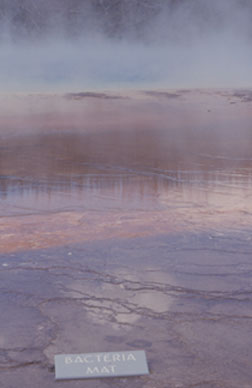
Hot Springs, Geysers, Etc.
If you have ever visited Yellowstone National Park in Wyoming, you undoubtedly noticed the beautiful colors of the hot springs, geysers, fumerols, and terraces as well as the overwhelming smell of sulfur. But did you ever stop to wonder what caused these things to occur?
Well, if you have, the answer to this question is microorganisms. Groups of bacteria and archaea known as hyperthermophiles (heat loving organisms which survive temperatures at 800C and above) thrive in these geothermal areas.
As the hot water of these thermal areas flows away from the source, the temperature decreases. Different types of bacteria inhabit the different temperature regions. The color is produced by the pigmentation of the microbes. This thermal stratification is evident in the photograph above.
The sulfur smell associated with these areas are the work of sulfur reducing microbes. These microorganisms take in sulfur from their environment and give off hydrogen sulfide as a waste product (which provides us with the aroma we experience when visiting the area). For more images of Yellowstone's geothermal activity, please visit Tim Ross on the Web!!!
|
